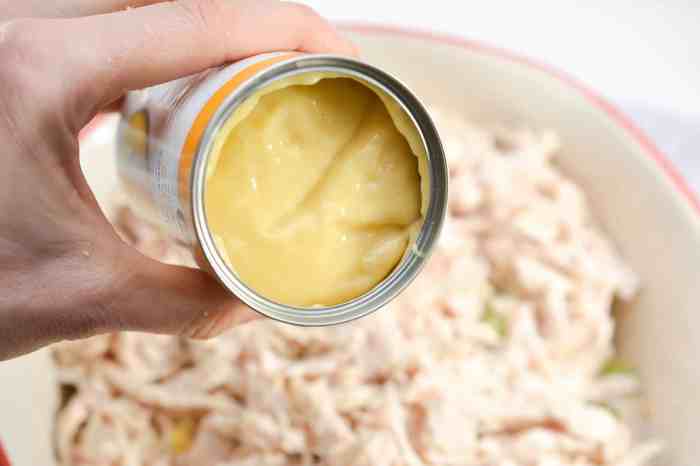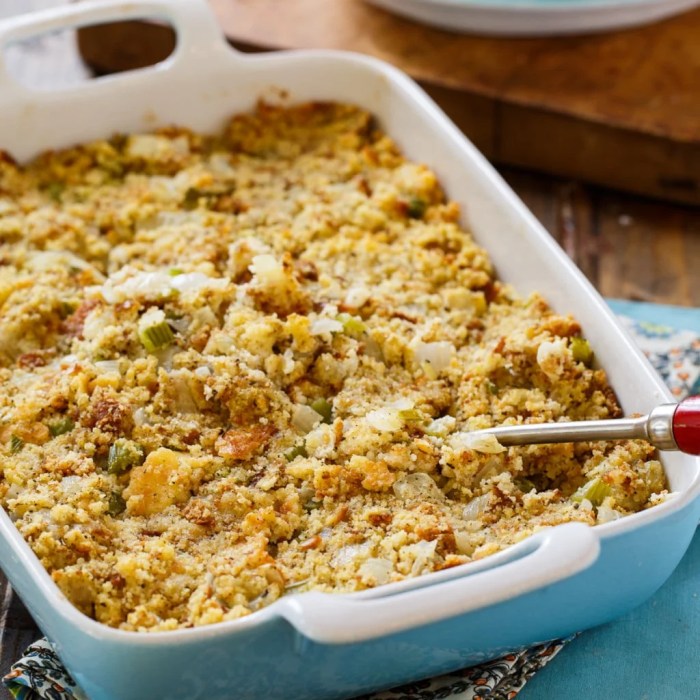Cornbread Dressing Recipe Variations and Techniques: Cornbread Dressing Recipe With Cream Of Chicken Soup

Source: sweetpeaskitchen.com
Cornbread dressing recipe with cream of chicken soup – This article explores the versatility of cornbread dressing recipes using cream of chicken soup, offering variations, ingredient substitutions, cooking methods, presentation ideas, and nutritional information. We’ll delve into different cornbread types, explore alternative soup bases, and provide adaptable techniques for diverse dietary needs.
Cornbread Dressing Recipe Variations

Source: spicysouthernkitchen.com
Several variations enhance the classic cornbread dressing recipe. Experimenting with different cornbread types significantly impacts the texture and flavor profile. Incorporating wild rice adds a nutty complexity, while the addition of sausage provides a savory depth. A vegetarian option, substituting cream of mushroom soup, maintains the comforting essence of the dish.
- Jiffy Mix Cornbread Dressing: This uses a readily available cornbread mix for convenience, resulting in a slightly sweeter, more tender dressing.
- Homemade Buttermilk Cornbread Dressing: A homemade buttermilk cornbread offers a tangier, more crumbly texture, enhancing the overall flavor profile.
- Spicy Cornbread Dressing (with Jalapeños): Adds a kick with chopped jalapeños incorporated into the cornbread or dressing mixture.
- Wild Rice Cornbread Dressing: Wild rice contributes a nutty flavor and chewy texture, adding depth and visual appeal.
- Sausage Cornbread Dressing: Adding cooked sausage (Italian, chorizo, or breakfast sausage) brings a savory, meaty element.
- Vegetarian Cream of Mushroom Cornbread Dressing: Replacing cream of chicken soup with cream of mushroom soup creates a delicious vegetarian alternative.
Ingredient Substitutions and Their Effects, Cornbread dressing recipe with cream of chicken soup
Adapting the recipe to available ingredients is straightforward. Substituting ingredients may subtly alter the final product’s texture and taste.
- Buttermilk for Milk in Cornbread: Buttermilk imparts a tangier flavor and creates a slightly more tender crumb.
- Cream of Chicken Soup Alternatives: Cream of mushroom soup offers an earthy alternative, while chicken broth provides a lighter, less creamy version. Using vegetable broth creates a vegetarian option.
- Celery and Onion Substitutes: Leeks or scallions can replace onions, while carrots or bell peppers can partially substitute celery, though the flavor profile will change slightly.
- Herb and Spice Variations: Experiment with different herbs (sage, thyme, rosemary) and spices (black pepper, poultry seasoning) to customize the flavor to your preference. A blend of herbs de Provence adds a distinctly Mediterranean touch.
Cooking Methods and Baking Techniques
The cornbread dressing can be prepared in various ways, each impacting cooking time and texture.
- Cast Iron Skillet Method: Provides a crispy bottom and evenly cooked dressing. A well-seasoned cast iron skillet is recommended.
- 9×13 Inch Baking Dish Method: A standard baking dish offers even baking and easy serving.
- Baking Time and Temperature Comparison: Baking times vary based on the cooking method and oven. A 9×13 inch dish generally requires 30-45 minutes at 350°F (175°C), while a cast iron skillet may require slightly less time.
- Make-Ahead and Reheating Instructions: The dressing can be prepared a day ahead, refrigerated, and reheated gently before serving. This is especially useful for holiday gatherings.
Cornbread Dressing Presentation and Serving Suggestions
Visual appeal enhances the dining experience. A well-presented dish elevates the overall impression.
- Visually Appealing Presentation: Consider garnishing with fresh herbs (parsley, thyme), toasted pecans, or a sprinkle of grated Parmesan cheese.
- Serving Suggestions: Serve alongside roasted turkey, as a stuffing for chicken breasts, or as a side dish with other holiday favorites like mashed potatoes and gravy.
| Presentation Style | Description | Pros | Cons |
|---|---|---|---|
| Casserole Dish | Served in a large baking dish, family-style. | Easy serving, visually appealing in a large format. | May not be suitable for smaller gatherings. |
| Individual Ramekins | Individual portions in small ramekins. | Elegant, portion control, suitable for formal settings. | More time-consuming to prepare and serve. |
| Bread Bowl | Served inside a hollowed-out loaf of bread. | Visually striking, unique presentation. | Requires extra preparation for the bread bowl. |
| Muffin Tins | Baked in individual muffin tins. | Easy to serve, portion controlled, good for buffets. | May require adjusting baking time. |
Nutritional Information and Dietary Adaptations
Nutritional content varies depending on ingredients. Adapting the recipe for specific dietary needs is possible.
- Nutritional Breakdown (Approximate): This will vary greatly depending on the specific ingredients and quantities used. A typical serving might contain approximately 250-350 calories, varying levels of fat, carbohydrates, and protein. Consult a nutrition calculator for a precise breakdown based on your recipe.
- Gluten-Free Adaptation: Use gluten-free cornbread mix or make cornbread from scratch using gluten-free flour blend.
- Sodium Reduction: Use low-sodium cream of chicken soup and reduce the amount of salt added.
- Lower-Fat Modification: Reduce the amount of butter or oil used in the cornbread and the dressing. Consider using Greek yogurt instead of some of the cream of chicken soup.
Visual Descriptions for Image Generation
Detailed descriptions aid in visualizing the dish.
- Baked Cornbread Dressing: A golden-brown, slightly crispy top with a moist, tender interior. The texture is crumbly yet cohesive, with visible flecks of cornmeal and herbs. The color is a warm, inviting brown, possibly with darker spots where the sausage or other additions are incorporated.
- Ingredients Before Combining: A vibrant array of ingredients: cubes of cornbread, chopped celery and onion, a creamy base of cream of chicken soup, and perhaps savory sausage pieces or wild rice. The colors are a mix of browns, greens, and whites.
- Perfectly Set Table: A rustic yet elegant table setting. The cornbread dressing sits proudly in a large, earthenware casserole dish, surrounded by other Thanksgiving favorites: a roasted turkey, mashed potatoes, gravy, cranberry sauce, and green bean casserole. The table is adorned with autumnal decorations, creating a warm and inviting atmosphere.
Expert Answers
Can I freeze leftover cornbread dressing?
Yes, cornbread dressing freezes well. Allow it to cool completely, then store it in an airtight container for up to 3 months. Reheat gently in the oven or microwave.
What if I don’t have fresh herbs?
Dried herbs can be substituted for fresh herbs. Use approximately 1/3 the amount of dried herbs as you would fresh herbs.
How can I make this recipe spicier?
Add a pinch of cayenne pepper, a dash of hot sauce, or some chopped jalapeños for extra heat.
A creamy cornbread dressing, made with cream of chicken soup, is a comforting classic. For a heartier meal, consider adding some sautéed vegetables, perhaps inspired by the robust flavors found in a vegetable soup with hamburger recipe. The richness of the hamburger soup complements the savory cornbread base, offering a nice contrast in textures and tastes.
Returning to the cornbread dressing, you might even experiment with adding some of the leftover cooked vegetables for an extra layer of flavor.
Can I use a different type of bread besides cornbread?
While cornbread is traditional, you can experiment with other breads like cubed white bread or sourdough, but adjust the liquid accordingly for proper moisture.
